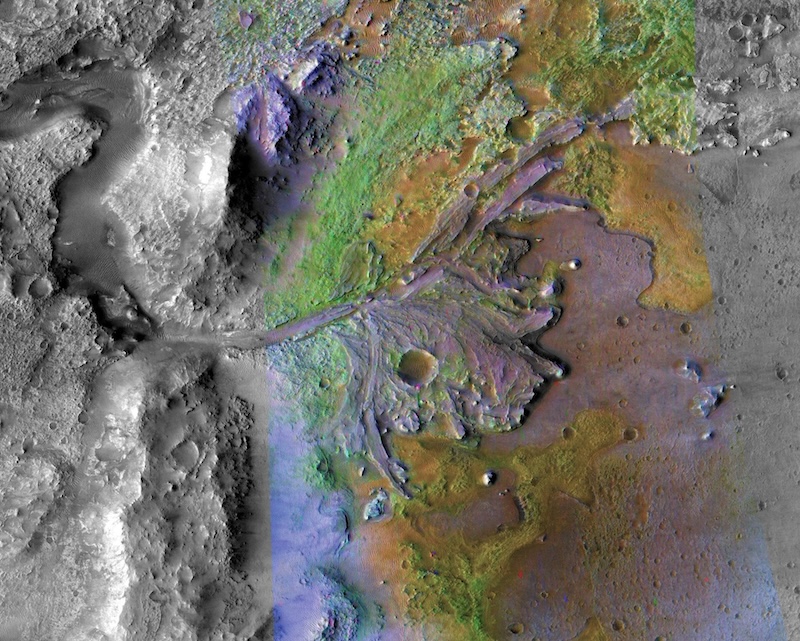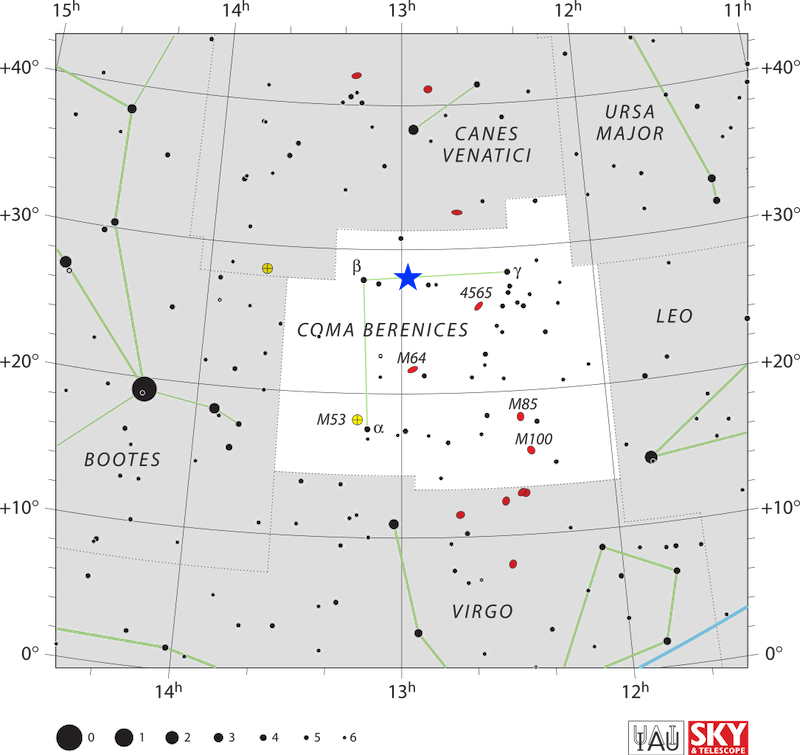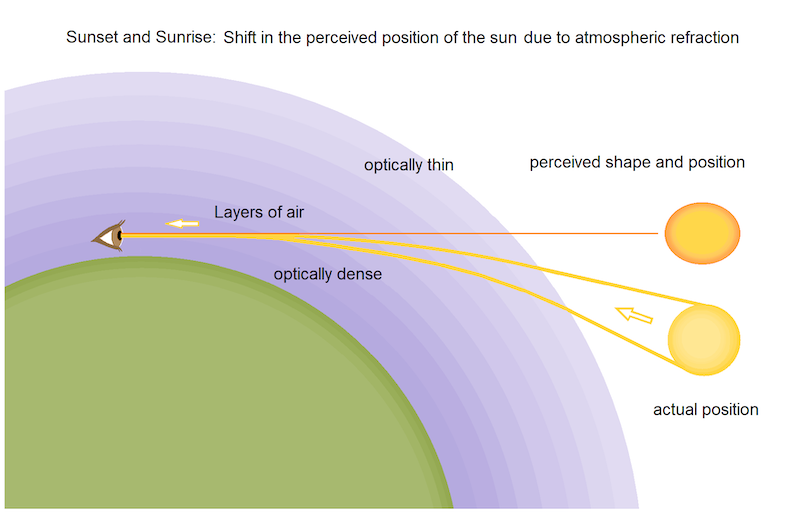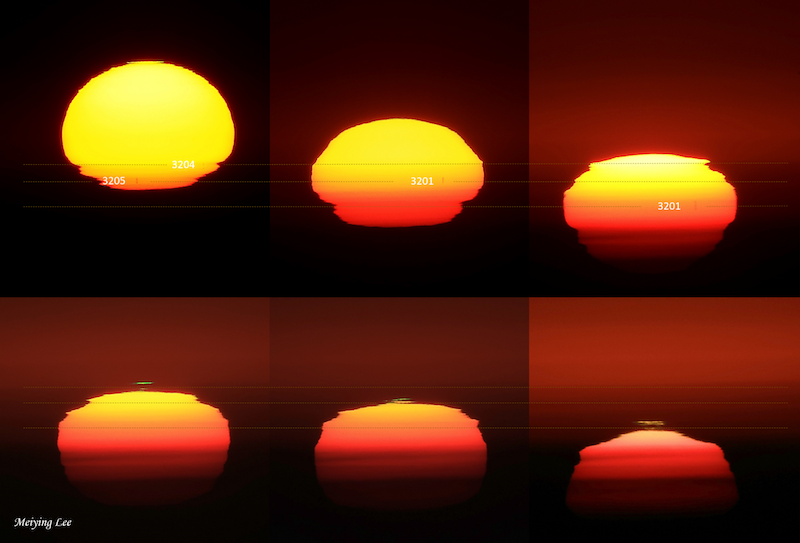
Science matters. Wonder matters. You matter.
Join our 2025 Donation Campaign today.
- Hydrothermal systems – hot underground water – are common on Earth. Did they also once exist on Mars?
- NASA’s Perseverance rover has found silica-rich rocks in Jezero crater. This includes the first confirmed discovery of quartz. The various silica deposits are evidence of ancient hydrothermal activity on Mars.
- On Earth, hydrothermal systems provide habitats for many different kinds of microbes. Silica-rich rocks are also ideal for preserving traces of ancient microbial organisms.
Hydrothermal activity on Mars?
NASA’s Perseverance rover has been in the news a lot recently, with findings that hint at possible ancient microbial life on Mars. And now, the intrepid rover has made yet another intriguing discovery. On April 2, 2025, an international team of researchers said that Perseverance has found evidence for previous hydrothermal – hot water – activity where it landed in Jezero crater. The rover detected crystallized quartz and hydrated silica in rocks it analyzed, suggesting heated water and potential habitability for microbes.
The researchers, from Grenoble Alpes University, CNRS, Sorbonne Université and other French institutions, published their peer-reviewed results in Earth and Planetary Science Letters on February 28, 2025. The paper is also included in volume 656 of the journal (April 15, 2025).
Silica-rich rocks
Perseverance found rocks containing opaline silica (opal), chalcedony and quartz at three locations. They are at the edge of the ancient delta inside Jezero crater, along the riverbed that connects to the delta and on the edge of the crater rim. The rover used its SuperCam instrument to identify the silica minerals. This involved a combination of laser-induced breakdown spectroscopy (LIBS), infrared (IR) and Raman spectroscopy.
Overall, the researchers studied six samples that Perseverance obtained and analyzed.
Quartz and silica point to past hydrothermal activity on Mars
The researchers found high amounts of silicon, and some rocks were nearly pure silica. In addition, they also identified hydrated silica, opaline silica, chalcedony and well-crystallized quartz. In particular, the quartz is of special interest, since this is the first time that scientists have definitively identified it on Mars. Notably, this is the first time that quartz-dominated rocks have been confirmed on Mars.
Together, the deposits point to a likely hydrothermal origin for the minerals. The paper states:
Quartz-dominated stones are detected unambiguously for the first time on the Martian surface, and based on grain size and crystallinity are proposed to be of hydrothermal origin. Although these rocks were all found as float, we propose that these detections are part of a common hydrothermal system, and represent different depths/temperatures of precipitation. This attests that hydrothermal processes were active in and around Jezero crater, possibly triggered by the Jezero crater-forming impact.


Implications for possible past life
So, why is hydrothermal activity significant? Hydrothermal systems – heated underground water – are common on Earth. Although the water is super hot, it provides habitable conditions for a wide variety of microscopic life. Could the same have been true on Mars?
Also, such silica-rich rocks are ideal for preserving traces of once-living microbes. Opaline silica is known for its ability to preserve both molecular and macroscopic biosignatures. Biosignatures are molecular, chemical or other traces of life. As the paper notes:
These silica-rich rocks, in particular opaline silica, are very promising targets for sampling and return to Earth given their high biosignature preservation potential.
Interestingly, NASA’s Spirit rover also found opaline silica back in 2008. But what made this silica even more interesting was its shape. Its outer layers were covered in tiny nodules that looked like heads of cauliflower. In fact, the cauliflower formations closely resembled ones on Earth, in the Atacama Desert in Chile, Yellowstone National Park in Wyoming and the Taupo Volcanic Zone in New Zealand, where microbial life was involved in their creation.

On the lookout for more silica rocks
Unfortunately, the rocks were too small for the rover to drill into and obtain samples that it could further analyze in its onboard mini-laboratory or store away for eventual return to Earth for the Mars Sample Return program. The rover team is eager to find more, however, as Perseverance continues exploring. For astrobiology research, the opaline silica and hydrated silica are of special interest, as the paper says:
Thus, the presence of opaline silica could be related to the presence of organic compounds, making it a promising target to explore the organic chemistry that once existed on early Mars. While the rock described in this work was too small for drilling and collection, the Perseverance rover team will be looking for similar targets in the coming years.
The discovery of hydrated silica is promising for the search for organic traces of life on Mars, since a hydrated silica matrix reduces the molecular degradation of fossil microorganisms over time, as demonstrated experimentally.
Indeed, the findings provide compelling evidence for not only hydrothermal activity on ancient Mars, but even potential habitability. It will be interesting to what else Perseverance – and its companion rover Curiosity – discovers, to be sure.
Bottom line: NASA’s Perseverance rover has found silica-rich rocks, including – for the first time – quartz. It’s compelling evidence of ancient hydrothermal activity on Mars.
Read more: Life on Mars? Odd rings and spots tantalize scientists
Read more: Green spots in rocks on Mars intrigue rover scientists
The post Hydrothermal activity on Mars? Rover finds tantalizing new clues first appeared on EarthSky.
from EarthSky https://ift.tt/sJq6fV5

Science matters. Wonder matters. You matter.
Join our 2025 Donation Campaign today.
- Hydrothermal systems – hot underground water – are common on Earth. Did they also once exist on Mars?
- NASA’s Perseverance rover has found silica-rich rocks in Jezero crater. This includes the first confirmed discovery of quartz. The various silica deposits are evidence of ancient hydrothermal activity on Mars.
- On Earth, hydrothermal systems provide habitats for many different kinds of microbes. Silica-rich rocks are also ideal for preserving traces of ancient microbial organisms.
Hydrothermal activity on Mars?
NASA’s Perseverance rover has been in the news a lot recently, with findings that hint at possible ancient microbial life on Mars. And now, the intrepid rover has made yet another intriguing discovery. On April 2, 2025, an international team of researchers said that Perseverance has found evidence for previous hydrothermal – hot water – activity where it landed in Jezero crater. The rover detected crystallized quartz and hydrated silica in rocks it analyzed, suggesting heated water and potential habitability for microbes.
The researchers, from Grenoble Alpes University, CNRS, Sorbonne Université and other French institutions, published their peer-reviewed results in Earth and Planetary Science Letters on February 28, 2025. The paper is also included in volume 656 of the journal (April 15, 2025).
Silica-rich rocks
Perseverance found rocks containing opaline silica (opal), chalcedony and quartz at three locations. They are at the edge of the ancient delta inside Jezero crater, along the riverbed that connects to the delta and on the edge of the crater rim. The rover used its SuperCam instrument to identify the silica minerals. This involved a combination of laser-induced breakdown spectroscopy (LIBS), infrared (IR) and Raman spectroscopy.
Overall, the researchers studied six samples that Perseverance obtained and analyzed.
Quartz and silica point to past hydrothermal activity on Mars
The researchers found high amounts of silicon, and some rocks were nearly pure silica. In addition, they also identified hydrated silica, opaline silica, chalcedony and well-crystallized quartz. In particular, the quartz is of special interest, since this is the first time that scientists have definitively identified it on Mars. Notably, this is the first time that quartz-dominated rocks have been confirmed on Mars.
Together, the deposits point to a likely hydrothermal origin for the minerals. The paper states:
Quartz-dominated stones are detected unambiguously for the first time on the Martian surface, and based on grain size and crystallinity are proposed to be of hydrothermal origin. Although these rocks were all found as float, we propose that these detections are part of a common hydrothermal system, and represent different depths/temperatures of precipitation. This attests that hydrothermal processes were active in and around Jezero crater, possibly triggered by the Jezero crater-forming impact.


Implications for possible past life
So, why is hydrothermal activity significant? Hydrothermal systems – heated underground water – are common on Earth. Although the water is super hot, it provides habitable conditions for a wide variety of microscopic life. Could the same have been true on Mars?
Also, such silica-rich rocks are ideal for preserving traces of once-living microbes. Opaline silica is known for its ability to preserve both molecular and macroscopic biosignatures. Biosignatures are molecular, chemical or other traces of life. As the paper notes:
These silica-rich rocks, in particular opaline silica, are very promising targets for sampling and return to Earth given their high biosignature preservation potential.
Interestingly, NASA’s Spirit rover also found opaline silica back in 2008. But what made this silica even more interesting was its shape. Its outer layers were covered in tiny nodules that looked like heads of cauliflower. In fact, the cauliflower formations closely resembled ones on Earth, in the Atacama Desert in Chile, Yellowstone National Park in Wyoming and the Taupo Volcanic Zone in New Zealand, where microbial life was involved in their creation.

On the lookout for more silica rocks
Unfortunately, the rocks were too small for the rover to drill into and obtain samples that it could further analyze in its onboard mini-laboratory or store away for eventual return to Earth for the Mars Sample Return program. The rover team is eager to find more, however, as Perseverance continues exploring. For astrobiology research, the opaline silica and hydrated silica are of special interest, as the paper says:
Thus, the presence of opaline silica could be related to the presence of organic compounds, making it a promising target to explore the organic chemistry that once existed on early Mars. While the rock described in this work was too small for drilling and collection, the Perseverance rover team will be looking for similar targets in the coming years.
The discovery of hydrated silica is promising for the search for organic traces of life on Mars, since a hydrated silica matrix reduces the molecular degradation of fossil microorganisms over time, as demonstrated experimentally.
Indeed, the findings provide compelling evidence for not only hydrothermal activity on ancient Mars, but even potential habitability. It will be interesting to what else Perseverance – and its companion rover Curiosity – discovers, to be sure.
Bottom line: NASA’s Perseverance rover has found silica-rich rocks, including – for the first time – quartz. It’s compelling evidence of ancient hydrothermal activity on Mars.
Read more: Life on Mars? Odd rings and spots tantalize scientists
Read more: Green spots in rocks on Mars intrigue rover scientists
The post Hydrothermal activity on Mars? Rover finds tantalizing new clues first appeared on EarthSky.
from EarthSky https://ift.tt/sJq6fV5

























